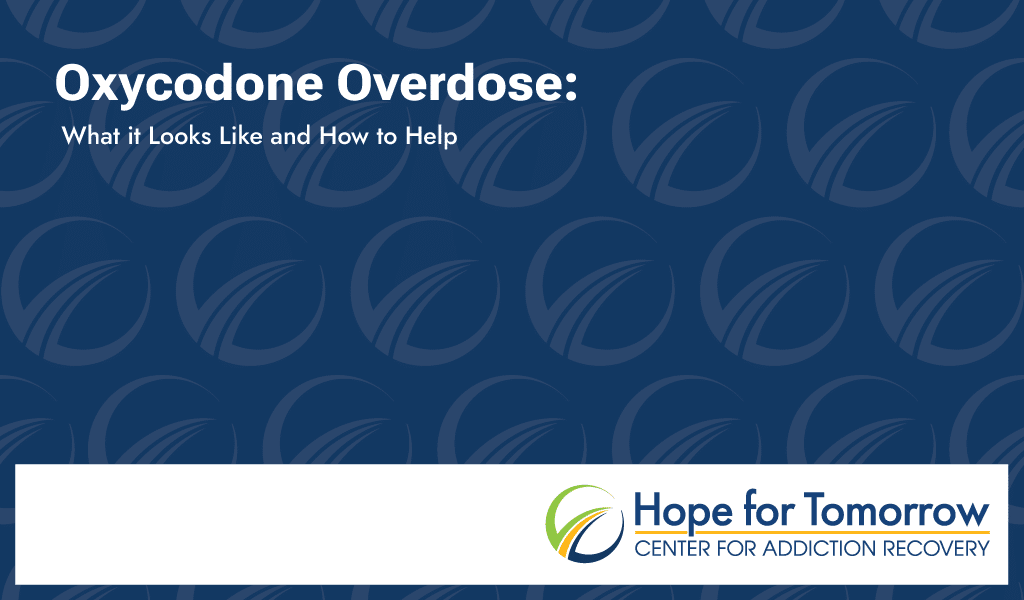

It may have started as the medication your doctor prescribed for pain management after surgery: OxyContin, Percodan, Roxicet. The painkiller not only took away the pain but also made you feel like you were floating on a cloud. It was an escape.
But life came crashing back down after the medication wore off, and along with it, the pain. So you took more and more, not knowing how much was too much. One day, you woke up in the hospital, and the doctor told you you were lucky to be alive.
If this story sounds like yours or a loved one’s, you’re not alone. Opioids, even the ones that come with a prescription, can be dangerous when used incorrectly. In 2022, 14,716 people died from overdosing on prescription opioids like oxycodone.
There is hope, however. Everyone is capable of recovering from oxycodone misuse if they seek oxycodone treatment. At Hope for Tomorrow, we see recovery happen every day. We are determined to help our patients live the lives they want to live, and sometimes an overdose is what prompts them to seek our help. Knowing the signs of an oxycodone overdose and how to help a loved one can be the first step to saving someone’s life.
An oxycodone overdose happens when a person takes more oxycodone than their body can safely handle.
When taking a safe dose of oxycodone, the medication blocks pain by slowing down and stopping pain messages sent by your brain to your nerves. Because it affects your whole nervous system, it also slows down other functions of the body, causing side effects like constipation, drowsiness, and nausea, even when taken correctly.
Taking too much oxycodone, however, causes the nervous system to move so slowly that your body cannot perform the tasks that it normally does, including breathing. This can lead to a life-threatening breakdown in the body.

The Risks: What Leads to an Oxycodone Overdose?
A person can overdose on oxycodone by using someone else’s medication, taking more medication than the dose prescribed by the doctor, or taking other substances not prescribed by their doctor alongside the oxycodone, like alcohol.
Sometimes a person doesn’t know they’re taking another substance with their oxycodone because they purchase their pills illegally through dealers. Illicitly purchased oxycodone can contain fentanyl or other drugs without the buyer knowing, which increases the risk of an overdose. Overdoses from fentanyl and prescription opioids taken together now outpace overdoses from prescription opioids alone.
When people take oxycodone outside of its intended use, it can cause euphoria, relaxation or sedation, feelings that a person may want to repeat. If repeated enough, a person’s brain is trained to desire the substance even if it’s harming them or putting them at risk of a deadly overdose.
You can also become physically dependent on oxycodone if you take it enough, causing withdrawal symptoms when you don’t take it. Your body then builds resistance to it, and you might have to take more to feel the effects. This ups your chances of accidentally overdosing.
Taking opioids alongside other substances increases the risk of overdose, especially if it is a substance that also slows down the central nervous system. These are called depressants and include alcohol, heroin, other prescription opioids, anti-anxiety medications, and sleeping pills. Combining these substances can cause someone’s breathing, blood pressure, and heart rate to drop to deadly low levels.
Warning Signs of an Oxycodone Overdose
Knowing the early symptoms of an oxycodone overdose can reduce the harm an overdose may have. It can mean the difference between life and death.
Here are three main signs to look for:
Call 911 immediately if you see these warning signs. Acting quickly is key to your loved one’s survival.
Spotting early warning signs is important, but there are other symptoms that a person may develop that indicate an oxycodone overdose. Watch out for all of these symptoms:
An oxycodone overdose can stop someone’s breathing, starving vital organs like the heart and brain from oxygen and causing them to stop working. This first causes a person to lose consciousness, then go into a coma, and lastly, if there is no intervention, the person will die.
Your brain cannot function without oxygen and, if starved of it even for a few minutes, will be damaged. A person will start experiencing permanent brain damage at about four minutes of not having oxygen. Death usually occurs four to six minutes into the brain receiving no oxygen.
While someone’s breathing does not always stop immediately in an overdose, the gravity of an overdose can not be understated. Bodies, while amazing in their complexity and strength, can stop working if substances like oxycodone cause natural processes to slow down or stop altogether. Luckily, the chance you or a loved one will experience a fatal overdose is greatly reduced when you go through a residential or outpatient treatment program like the one at Hope for Tomorrow.
What to Do if You Are Present During an Overdose
The first step if you believe you or someone else is experiencing an oxycodone overdose is to try to wake them up by yelling their name and firmly rubbing their chest with your knuckles. If they don’t wake up, immediately call 911. This is a medical emergency, and time is of the essence.
Next, if you have naloxone on hand, use it. Naloxone, a drug that sometimes goes by the brand name Narcan, is an opioid overdose reversal drug that will revive a person experiencing an overdose, returning their breathing to normal. Naloxone can be injected into a vein or sprayed into a person’s nostril using a nasal spray device. You should still seek emergency medical help after you use naloxone on a person experiencing an overdose because its reversal effects are temporary.
After administering naloxone, get the person onto their back, tip their head back, pinch their nostrils, put your mouth over theirs, and breathe into their mouth to fill their lungs. Do this every five seconds.
When a person’s breathing has returned to normal, roll them onto their side to recover so they don’t choke. Stay with them until medical professionals arrive and try to keep them awake.
When you call 911 during an overdose, it is helpful (but not necessary) to know a person’s age, weight, condition, the name of the drug and its strength, the time it was swallowed and how much was swallowed, and if the drug was prescribed to the person. The more information you can give to first responders, the more they can help.
West Virginia is one of many states with a Good Samaritan law, which means that a person who calls 911 to get help for someone experiencing an overdose will not get in trouble for being in possession of a controlled substance without a prescription.
The easiest way to prevent an oxycodone overdose is to only take the medication as your doctor prescribes it. If you use oxycodone outside of its prescribed use and it is interfering with your day-to-day life, you may have a substance use disorder that needs to be treated. Reach out for help if you experience any of these symptoms:
Noticing these symptoms in a loved one can be stressful, but they can heal. Talk to your child, partner, or friend about treatment if you think they may have a substance use disorder, and offer support in their journey to recovery. Your encouragement may mean the difference between them falling deeper into their disorder and getting the help they need. While life may seem bleak right now, recovery holds the key to a brighter future.

Overdoses are scary and traumatic to all of those involved, and getting help is the key to preventing one in the first place or stopping one from happening again. If you or someone you love are living with a substance use disorder, and you’re tired of the seemingly never-ending cycle, you are not alone.
Everyone going through recovery deserves empathy and individualized care. At Hope for Tomorrow, we focus on patients’ needs above all else.
Hope for Tomorrow provides residential and outpatient care for people experiencing addiction at our locations in Point Pleasant and Beckley, West Virginia. We use medication-assisted treatment in combination with cognitive behavioral therapy, family, group, and individual counseling. Our patients range from pregnant women to veterans to couples to people with other medical or mental health conditions. We take everyone. Call us today at 877-679-8162.
Treatment today for a brighter tomorrow.